We’ve all had those days when we’ve relied on a quick spritz of dry shampoo to refresh our hair and save us precious time. It’s a lifesaver, right? Well, it seems the pet care industry has picked up on our secret, bringing this convenience to our furry friends! But, just as we’re cautious about what we put on our bodies, it’s crucial to understand what goes onto our pets.
As the popularity of dry shampoos for humans soared, it wasn’t long before versions tailored for dogs started appearing on shelves. But the big question remains: Is it safe to use dry shampoo on our four-legged companions? How effective is it? And are there any precautions we should be aware of?
In this blog, we’ll dive deep into the world of dry shampoos for dogs, offering insights,vet cautions, and tips on usage. Let’s ensure our beloved pets remain fresh, clean, and above all, healthy! 🐾

What is Dry Shampoo For Dogs?
Ah, the wonders of dry shampoo! While most of us are familiar with the concept for humans, there’s a new player in town specifically tailored for our canine companions.
Dry shampoo for dogs is, in essence, a quick and waterless alternative to a traditional bath. Designed to cleanse and refresh a dog’s coat without the need for water, it’s a particularly handy solution for those chilly days or when you’re short on time. Just like its human counterpart, dry shampoo for dogs comes in various forms such as powders, sprays, and foams.
However, it’s essential to recognize the distinction between human and dog-specific dry shampoos. While they may operate on a similar principle – absorbing excess oils and odors – the formulations are significantly different. Dogs have a unique pH balance and skin sensitivity, which means products for humans could potentially harm or irritate their skin. Therefore, always ensure that the dry shampoo you’re reaching for is specifically crafted for canine use.
Moreover, while these products offer convenience, they aren’t intended to completely replace water baths. Instead, think of them as a temporary fix or a bridge between more thorough cleanings, ensuring your pup looks and smells presentable when you can’t give them a full bath.
To sum up, dry shampoo for dogs is a handy tool in a pet parent’s grooming arsenal, offering a quick-refresh option for their fur babies. But like all good things, it’s vital to use them wisely and in moderation.
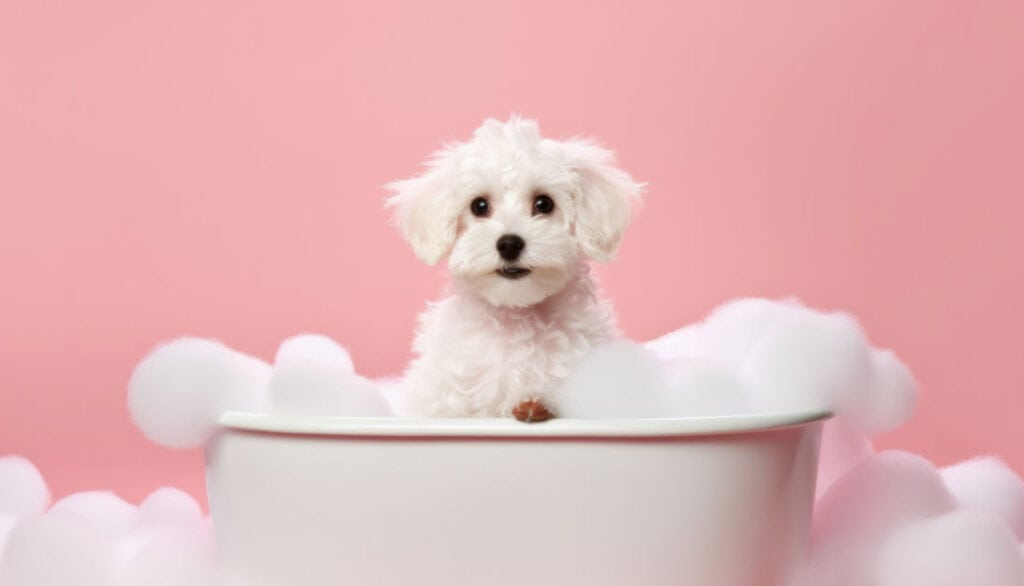
How Does Dry Dog Shampoo Work?
Let’s unravel the magic behind the bottle! Dry dog shampoo, at its core, works by tackling two primary pet concerns: excess oils and unwanted odors. Here’s a closer look at the process:
- Absorption Mechanism: The primary function of dry dog shampoo is its ability to absorb. Whether it’s in the form of a powder, spray, or foam, the product contains absorbent materials (like natural starches or minerals) that latch onto and soak up the excess oils present on a dog’s skin and coat. These oils, while natural, can accumulate over time, leading to a greasy appearance and feel.
- Neutralizing Odors: Beyond just cleaning, a good dry dog shampoo will also contain ingredients meant to neutralize odors, not just mask them. This is particularly beneficial for dogs who have a knack for finding smelly situations or those that naturally produce stronger odors. Some formulas may incorporate natural deodorizers, such as baking soda or certain botanical extracts, to keep your pup smelling fresh.
- Enhancing the Coat: Many dry dog shampoos also include conditioners or moisturizers, which help to leave the fur soft, manageable, and with a pleasant sheen. Ingredients like aloe vera or oatmeal can offer soothing properties, especially beneficial for dogs with sensitive skin.
- Application: The process is fairly straightforward. For powders, you’d sprinkle the product over your dog’s coat, massage it in with your fingers to ensure it reaches the skin, and then brush it out to remove excess product and distribute it evenly. Sprays and foams follow a similar method, though instead of sprinkling, you’d spray or apply the foam directly.
In essence, dry dog shampoos provide a quick and convenient method to refresh your dog’s coat and skin without the need for a full bath.

Is Dry Shampoo Effective?
As with most products, the effectiveness of dry dog shampoo often sparks debate among pet owners. Some swear by its convenience, while others believe nothing beats a traditional water bath. To provide a balanced view, let’s delve into the pros and cons of dry dog shampoo’s effectiveness.
| Pros | Cons |
|---|---|
| Quick Cleaning: Offers a fast solution for spot cleaning when your dog rolls into something unpleasant or gets greasy. | Doesn’t Replace Deep Cleaning: Doesn’t provide the deep cleaning of a traditional water bath. |
| Convenience: No water, no mess! Ideal for when a full bath isn’t practical, like during travel or cold weather. | Residue Buildup: Overuse can result in product accumulation, causing potential skin issues. |
| Odor Neutralization: Effective in combating common doggy odors, especially after outdoor play. | May Not Tackle All Odors: Might not address odors from medical issues, requiring vet care. |
| Beneficial for Sensitive Skin: Especially if formulated with soothing ingredients, dry shampoos can be gentler on sensitive skin. |
Dry dog shampoo can be effective for specific situations and purposes. It’s a valuable tool for temporary fixes and providing quick refreshes. However, it shouldn’t be seen as a complete replacement for traditional baths. Like all grooming products, its effectiveness also largely depends on the product’s quality, its ingredients, and its suitability for your dog’s specific needs. Always read reviews, consider your dog’s unique requirements, and consult with your veterinarian or a professional groomer when in doubt.
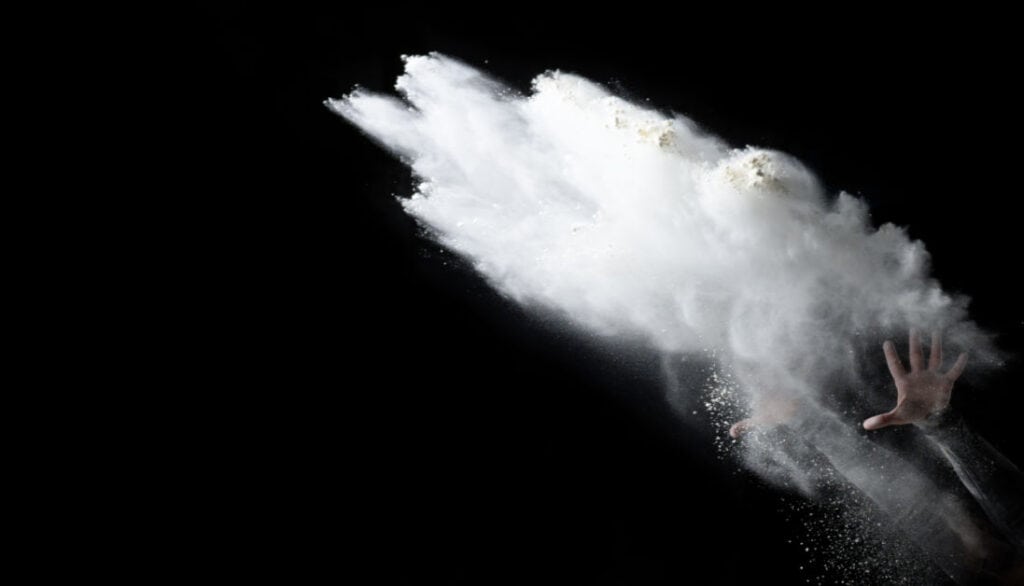
Avoid Long-Term Exclusive Use
While dry shampoos for dogs offer a quick and convenient solution for those in-between moments, relying solely on them for the long haul can lead to potential problems. Let’s dive into why it’s essential to strike a balance and not use dry shampoo as the only grooming method for extended periods.
- Skin and Coat Health: A dog’s skin and coat require regular and thorough cleaning to remove dirt, debris, and potential allergens. Dry shampoos can only absorb and mask to a certain extent. Over time, without a proper water-based bath, the accumulated grime can lead to skin irritations, inflammations, and other dermatological issues.
- Residue Buildup: As previously mentioned, consistent use of dry shampoo without interspersed water baths can lead to product buildup. This residue can clog hair follicles, potentially leading to issues like folliculitis (inflamed hair follicles) or exacerbate existing skin conditions.
- Inadequate Parasite Control: Dry shampoos aren’t designed to tackle or prevent parasites like fleas, ticks, or mites. If you’re only using dry shampoo, you might be giving these pesky critters an unchecked playground. Regular water baths, especially with medicated or parasite-control shampoos, help keep these unwanted guests at bay.
- Potential for Masking Issues: Continuously using dry shampoo might mask underlying health problems. For instance, a persistent foul odor might indicate a skin infection, but if it’s continually neutralized by the shampoo, you might miss the early signs of the issue.
- Natural Oil Distribution: While dry shampoos absorb excess oil, regular brushing and water-based baths help distribute natural oils across the dog’s coat. These oils are crucial for maintaining skin health and ensuring the coat remains shiny and conditioned.
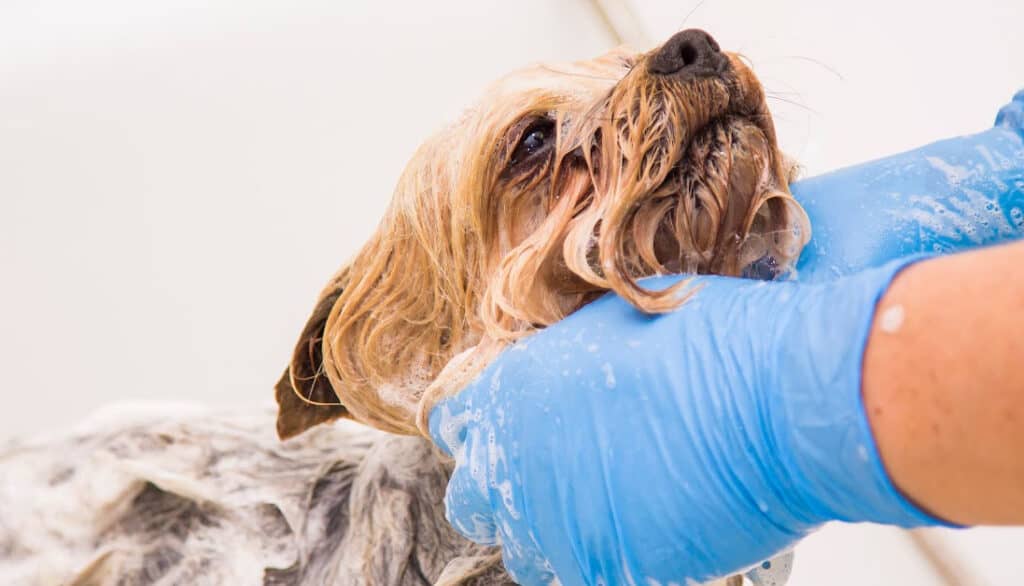
The Right Balance:
It’s essential to see dry dog shampoo as a supplementary tool in your grooming kit rather than the primary solution. Aim to give your dog regular water baths based on their breed, activity level, and specific needs. For example, a dog that enjoys outdoor activities might require more frequent baths compared to an apartment-dwelling pup. Always monitor your dog’s skin and coat health and consult with a vet if you notice any abnormalities.
In essence, while dry shampoos are fantastic for those quick fixes, they should be used judiciously, complementing a holistic grooming routine that prioritizes your dog’s overall well-being.

Avoid Using Too Much Dry Shampoo
When it comes to using products on our pets, the adage “less is more” often rings true. Dry shampoos for dogs, while convenient, can become problematic when overused. Here’s a closer look at why moderation is key and the potential issues with excessive application.
Potential Problems with Overuse:
- Skin Irritation: Just like in humans, excessive use of dry shampoo on dogs can lead to skin irritation. The residue from the shampoo can clog pores, leading to redness, itchiness, and discomfort for your furry friend.
- Residue Buildup: Continual application without thorough brushing or occasional water baths can lead to a buildup of the product on your dog’s skin and coat. This not only affects the appearance and feel of their fur but can also interfere with their natural skin functions.
- Masking Underlying Issues: Over-relying on dry shampoo might mask more severe health or hygiene issues. For instance, an unpleasant odor might be a sign of a skin infection or other medical condition. If we’re continually masking this with dry shampoo, we might overlook the root problem.
- Ingesting Harmful Ingredients: Dogs groom themselves, and if there’s too much residue from the dry shampoo on their fur, they might ingest it. Depending on the product’s ingredients, this could be harmful in large amounts.
- Coat Dullness: A dog’s coat can become dull and lackluster with the overuse of dry shampoo. The natural oils that give their fur a shiny appearance can get absorbed or masked by the product.
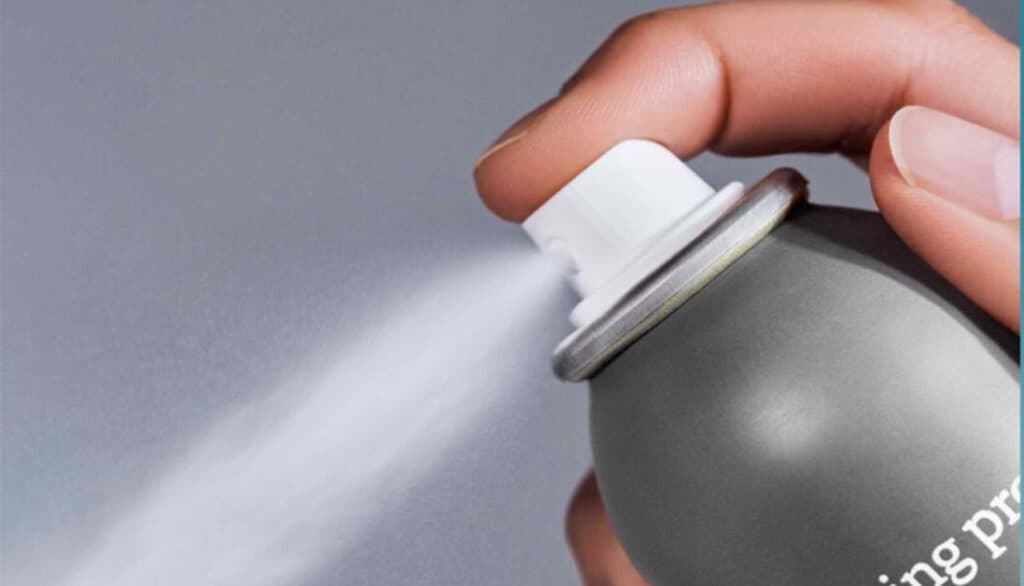
Tips to Use Dry Shampoo Properly:
- Follow Instructions: Always read the label and follow the manufacturer’s instructions. They’ll provide guidance on the amount to use and how frequently to apply it.
- Watch for Signs: If your dog starts scratching more than usual, or you notice any redness or irritation on their skin after using dry shampoo, it might be a sign to cut back or switch products.
- Combine with Regular Grooming: Ensure you’re regularly brushing your dog’s coat to distribute the natural oils and remove any residue from the dry shampoo.
- Consult a Vet: If you’re unsure about how much and how often to use dry shampoo, or if you notice any adverse reactions, always consult with your veterinarian. They can provide guidance tailored to your dog’s specific needs.
Dry shampoo is a fantastic tool for quick freshen-ups between baths, but it’s crucial to use it in moderation. By being attentive to your dog’s needs, reading product instructions, and consulting professionals when in doubt, you can ensure your dog benefits from the convenience of dry shampoo without any of the potential downsides.

Avoid Potentially Dangerous Dry Shampoo Ingredients
In the expanding world of pet care products, not every ingredient thrown into the mix is necessarily safe for our canine companions. Just as we’ve become more conscious of what we put on our own bodies, it’s equally important to be discerning when it comes to our pets. When shopping for a dry dog shampoo, it’s crucial to read the ingredient list carefully. Here are some potentially dangerous ingredients to watch out for:
- Alcohol: While it acts as a drying agent in many cosmetic products, it can be too harsh on a dog’s skin, leading to dryness and irritation.
- Artificial Fragrances: Synthetic fragrances can mask unpleasant smells, but they can also irritate a dog’s sensitive nose and skin. It’s better to look for products that use natural essential oils for fragrance, and even then, ensure they’re safe for dogs.
- Parabens: These are preservatives used in many cosmetic products, but they have been linked to various health concerns. Choose products that are paraben-free.
- Phthalates: Often used to enhance the longevity of fragrances, phthalates have been linked to hormonal disruptions in various studies. It’s best to avoid products containing this compound.
- Talc: While it’s excellent for absorbing moisture, there have been concerns about talc’s safety, especially if it contains asbestos. Opt for products using safer absorbents.
- Artificial Colors: Dogs don’t care what color their shampoo is! Artificial colors can cause allergic reactions in some dogs, so they’re best avoided.
- Isopropyl (Rubbing) Alcohol: This can be very drying and irritating to a dog’s skin. It’s essential to differentiate between this and fatty alcohols, which can be moisturizing.
- Propylene Glycol: Often used as a skin conditioner, it can be harmful if ingested in large amounts and can sometimes cause skin irritation.

Safe Alternatives:
Many reputable dog shampoo brands prioritize natural and safe ingredients, like oatmeal for soothing, baking soda for odor control, or aloe vera for moisturization. Look for products that highlight these natural components and always do a patch test to see if your dog has any reactions before using any product fully.
Your dog’s skin and coat are barriers against environmental factors, so it’s vital to treat them with care. When choosing a dry shampoo (or any pet product), always read labels thoroughly, do your research, and when in doubt, consult with your veterinarian. Remember, what works for one dog might not work for another, so it’s crucial to find what’s best for your individual pet’s needs.
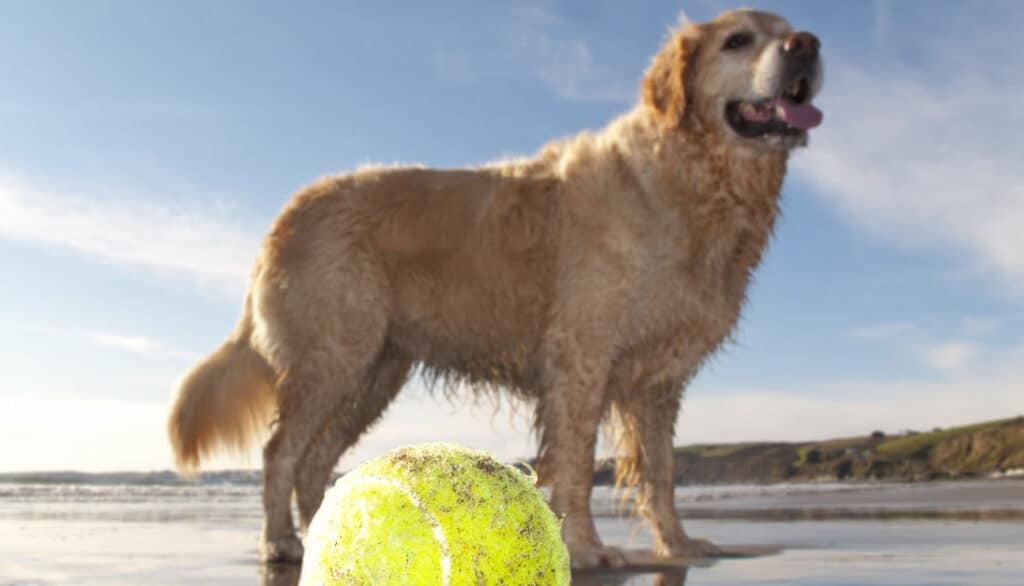
Avoid Dry Shampoos that “Stop” or “Prevent” Oil
The concept of “stopping” or “preventing” oil might sound appealing, especially if you’re trying to extend the time between your dog’s baths. After all, less oil often means less odor and a fresher appearance, right? However, it’s essential to understand why such claims can be misleading and potentially harmful for your furry friend.
- Natural Oil Production is Essential: A dog’s skin naturally produces oils that play a critical role in maintaining skin health and coat shine. These oils provide a barrier against environmental irritants, help retain moisture, and keep the skin supple. Any product that claims to “stop” or “prevent” this natural process can interfere with the skin’s ability to protect and repair itself.
- Potential for Over-Drying: Dry shampoos that focus on halting oil production can excessively dry out the skin. Over-dry skin can lead to itchiness, flakiness, and increased vulnerability to irritations and infections.
- Misleading Claims: Sometimes, these claims can be marketing gimmicks without real substance. They might not necessarily halt oil production but might just mask the effects for a short period, leading you to believe they’re working.
- Compromised Skin Barrier: A balanced skin pH and oil production are vital for a robust skin barrier. Products that disrupt this can weaken the skin’s natural defenses, making it easier for allergens, pollutants, and pathogens to penetrate.
- Potential for Irritation or Allergies: Products that contain strong astringents or other chemicals to reduce oil can irritate some dogs, especially those with sensitive skin or existing skin conditions. It can also increase the risk of allergic reactions.

What to Look For Instead:
- Balancing Ingredients: Instead of looking for products that stop oil, seek those that help balance oil production. Ingredients like oatmeal or chamomile can soothe the skin without stripping it of its natural oils.
- Natural Absorbents: Ingredients such as cornstarch or natural clays can absorb excess oil without halting its production, providing a balanced approach to oil control.
- Clear Ingredient Lists: Always prioritize products with clear, understandable ingredient lists. If you’re uncertain about any component, a quick online search or consultation with your vet can provide clarity.
- Products Suited for Your Dog’s Skin Type: Just as humans have different skin types, dogs do too. Some might naturally produce more oil, while others have drier skin. Choose products tailored to your dog’s specific needs.
While the promise of stopping or preventing oil might seem tempting, it’s essential to approach such claims with caution. Dogs, like humans, need a certain amount of natural oil for healthy skin and a shiny coat. Rather than trying to eliminate this, aim for products that help maintain a healthy balance. Your dog’s skin health and comfort should always be the top priority.
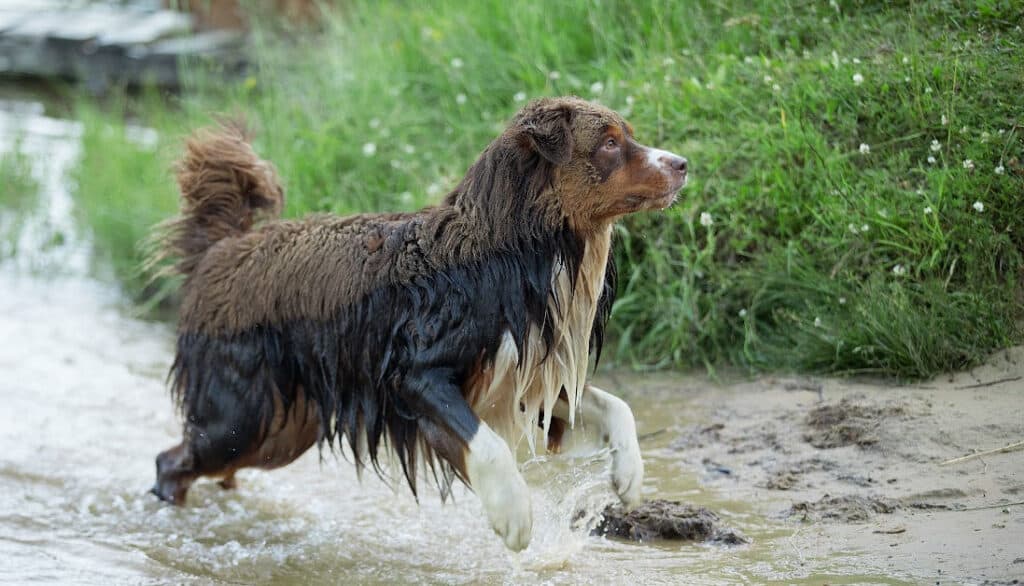
Avoid Dry Shampoos that Don’t List Ingredients
Transparency in product labeling is crucial, especially when it comes to products we use on our beloved pets. Dry shampoos that don’t provide a clear list of ingredients can be a potential hazard for your dog. Let’s discuss why it’s so essential to avoid such products and what you can do to ensure you’re making informed choices.
- Potential Hidden Toxins: Without a clear ingredient list, you can’t be certain what you’re putting on your dog’s skin. There might be harmful chemicals, toxins, or allergens that could harm your dog or cause reactions.
- Allergic Reactions: If your dog has known allergies or sensitivities, a lack of ingredient transparency can be especially dangerous. Without knowing what’s in the product, you run the risk of exposing your dog to something they’re allergic to.
- Regulatory Concerns: Products that don’t list their ingredients might not be adhering to regulatory standards or guidelines. This lack of oversight can indicate a lower quality product or one that hasn’t been adequately tested for safety.
- Lack of Accountability: Companies that are transparent about their product ingredients are often more accountable. They stand by the safety and effectiveness of their products. A missing ingredient list can be a red flag about the company’s ethics and trustworthiness.
- Inability to Make Informed Decisions: As a pet owner, you want the best for your dog. Without knowledge of what’s in a product, you’re unable to make an informed decision about whether it’s the right fit for your dog’s specific needs or health conditions.

How to Safeguard Against Unclear Products:
- Research Brands: Stick to reputable brands known for their transparency and ethical practices. Often, these brands will have numerous reviews, clear company practices, and perhaps even endorsements from veterinarians or pet professionals.
- Consult Your Veterinarian: If you’re unsure about a product, your vet can be an invaluable resource. They can offer recommendations or help you evaluate the safety of a particular product.
- Read Reviews: Other pet owners’ experiences can provide insights into a product’s effectiveness and safety. While individual experiences can vary, a pattern of concerns or complaints should be taken seriously.
- Reach Out to Companies: If you’re interested in a product but notice the ingredients aren’t listed, consider reaching out to the company directly. Their willingness (or lack thereof) to provide information can be telling.
- Trust Your Instincts: If something feels off or too good to be true, trust your gut. It’s always better to err on the side of caution when it comes to your dog’s health and well-being.
A clear list of ingredients is more than just a label; it’s a company’s pledge of transparency and a tool for pet owners to make informed decisions. Always prioritize your dog’s safety and health by choosing products that are forthright about what they contain. When in doubt, opt for products that have a proven track record of safety, effectiveness, and transparency.
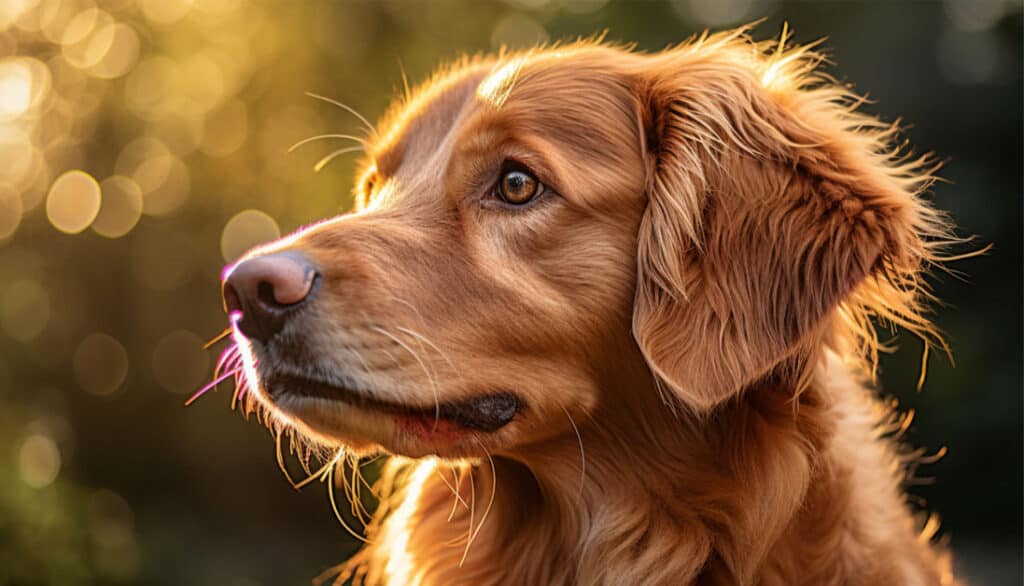
Should You Use Dry Shampoo on Your Dog?
The use of dry shampoo for dogs is a topic that has garnered much attention in recent years. As with any pet care product, there are pros and cons to consider. Let’s delve into the advantages and drawbacks of using dry shampoo for your canine companion to help you make an informed decision.
The Benefits:
- Convenience: One of the main attractions of dry shampoo is the sheer convenience it offers. If you’re short on time or your dog isn’t particularly fond of water, a quick application can help freshen them up without the hassle of a full bath.
- Emergency Freshen-ups: Maybe your dog rolled in something smelly during a walk, or perhaps there’s an unexpected visitor who’s allergic to pet dander. Dry shampoo can be a lifesaver in such situations.
- Winter Grooming: During colder months, you might want to reduce the frequency of wet baths to prevent your dog from getting cold. Dry shampoo can be a great interim solution.
- For Senior or Ill Dogs: Older dogs or those with health issues might find it challenging to endure regular baths. Dry shampoo can be a gentle alternative for them.

The Concerns:
- Not a Complete Substitute: Dry shampoo is meant to be a temporary solution. Relying on it too heavily, as discussed earlier, can lead to skin and coat issues.
- Potential Irritants: As with any product, there’s a risk of allergic reactions or skin irritations, especially if the product contains harsh chemicals or fragrances.
- Residue Worries: Some dry shampoos might leave a residue on your dog’s coat, which they might ingest while grooming themselves.
- Masking Issues: Continual use might mask underlying skin conditions or health concerns. It’s essential to still regularly inspect your dog’s skin and coat, even if you’re using dry shampoos.
So, Should You Use It?
The answer depends on your dog’s specific needs and circumstances:
- Use Sparingly: Consider dry shampoo as a supplementary grooming tool, not a primary solution. It’s fantastic for occasional use but shouldn’t replace regular baths entirely.
- Know Your Dog: Some dogs might tolerate dry shampoo better than others. If your dog has sensitive skin, it’s essential to be cautious and choose a product formulated for sensitivity.
- Always Monitor: Keep an eye on your dog after using the product. If you notice any signs of discomfort, itching, redness, or other adverse reactions, discontinue use and consult your vet.
- Consult with a Vet: If you’re unsure about introducing dry shampoo into your dog’s grooming routine, your veterinarian can provide guidance based on your dog’s health and skin condition.
Dry shampoo can be a valuable tool in a pet owner’s arsenal, but like all tools, its effectiveness depends on how it’s used. Approach it as a convenient, occasional solution rather than a long-term replacement for regular baths. With proper usage and a keen eye for your dog’s well-being, dry shampoo can indeed be a beneficial addition to your dog’s grooming routine.
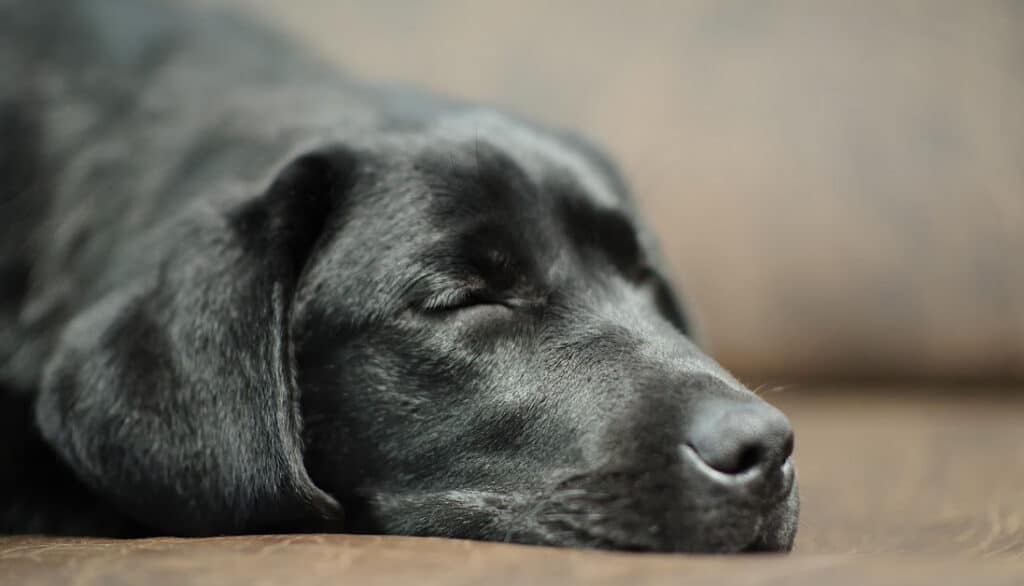
How to Use Dry Shampoo on Your Dog
Dry shampoo can be a godsend for busy pet owners, offering a quick and waterless way to freshen up your furry friend. But, as with any grooming product, there’s a right way and a wrong way to use it. Here’s a step-by-step guide to effectively and safely applying dry shampoo to your dog.
1. Choose the Right Product:
- Type of Dog: Some shampoos are tailored for specific breeds, sizes, or coat types.
- Ingredients: Opt for natural and hypoallergenic ingredients, especially if your dog has sensitive skin. Look for products with aloe vera, oatmeal, or chamomile for a soothing touch.
2. Prepare Your Dog:
- Brush First: Before applying dry shampoo, give your dog a thorough brushing to remove loose fur and tangles. This ensures even distribution of the product.
- Create a Calm Environment: Choose a quiet and comfortable location to ensure your dog stays calm during the process.
3. Application:
- Shake Well: Ensure the product is well mixed before application.
- Apply Sparingly: Remember, less is more. Begin with a small amount and add more if necessary.
- Massage: Gently massage the dry shampoo into your dog’s coat, ensuring it reaches the skin. This also helps distribute the product evenly.
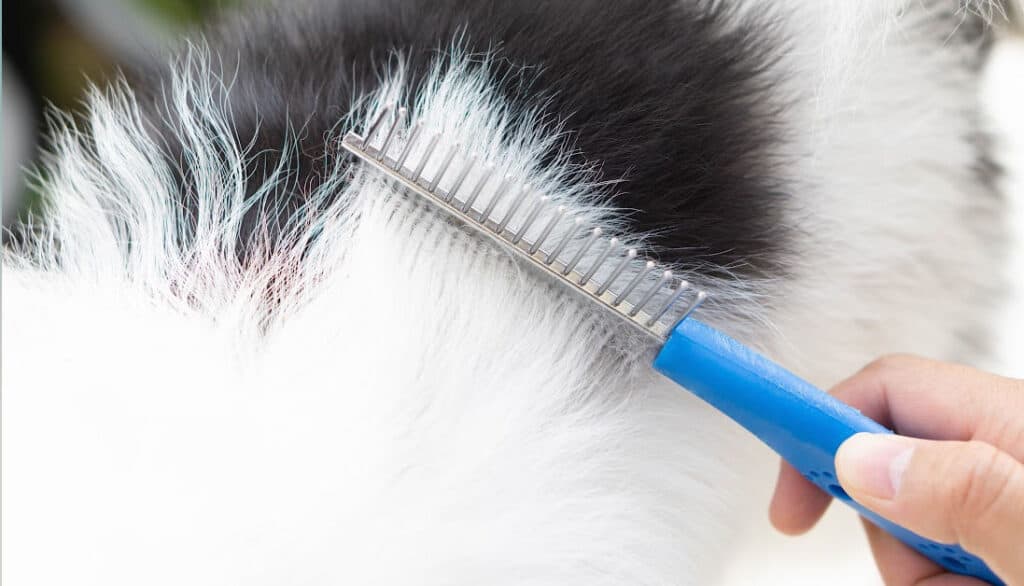
4. Wait and Brush:
- Let it Set: Follow the product’s instructions on how long to let it sit. Usually, a few minutes is enough for the shampoo to absorb oil and dirt.
- Brush Again: After allowing the product to set, brush your dog’s coat again. This will help remove excess product and any dislodged dirt.
5. Monitor Your Dog:
- Observe Reactions: Keep an eye out for any itching, redness, or discomfort. If you notice any adverse reactions, stop using the product and consult your veterinarian.
- Avoid Ingestion: Dogs may be tempted to lick their fur. While most dry shampoos are safe, excessive ingestion isn’t ideal. Monitor your dog to prevent them from ingesting too much of the product.
6. Keep Regular Bathing in the Routine:
- Supplement, Not Replace: Dry shampoo is meant to supplement, not replace, regular water baths. Ensure you’re still giving your dog traditional baths to maintain their overall skin and coat health.
7. Store Safely:
- Keep Out of Reach: As with all pet products, store the dry shampoo in a place where your dog can’t access it.
Using dry shampoo on your dog is a straightforward process, but it’s essential to do it correctly. By choosing the right product, preparing your dog, and following these steps, you can ensure a positive experience for both you and your furry friend. Remember to always prioritize your pet’s comfort and well-being, and when in doubt, consult a professional.
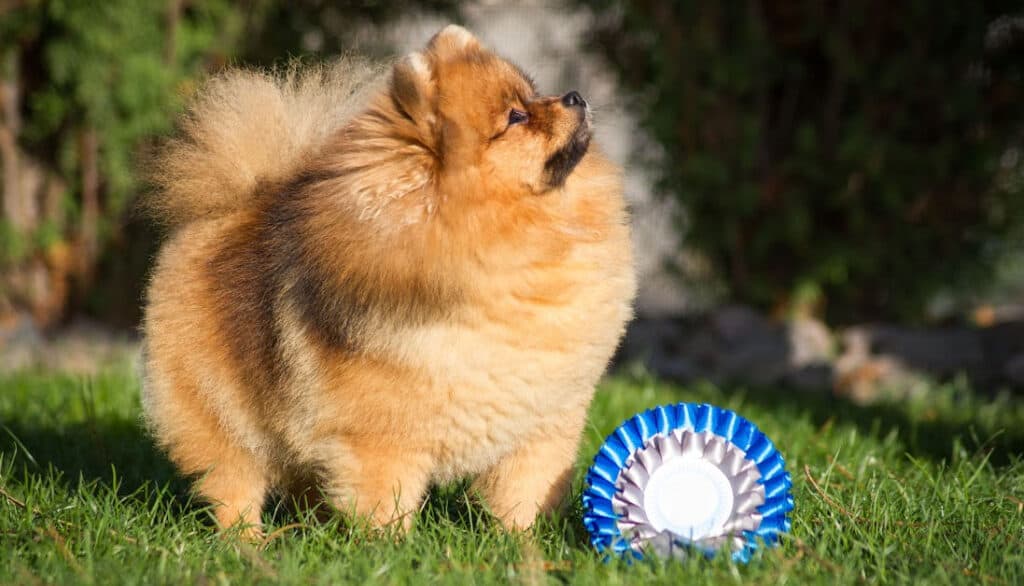
Conclusion
Navigating the world of pet grooming can sometimes feel like a daunting task, especially with the myriad of products available in the market. Dry shampoo for dogs is undoubtedly a boon for many pet owners, offering convenience and quick solutions in between regular baths. However, as we’ve delved into, it’s essential to use it wisely and in moderation.
Every dog is unique, and while one might benefit from a certain product, another might react differently. It’s crucial to always prioritize your dog’s health and comfort above all. Remember to always read product labels, observe your dog for any changes or reactions, and consult with professionals, like your trusted veterinarian, when in doubt.
In the end, our dogs rely on us for their well-being. By staying informed and making thoughtful choices, we can ensure they remain happy, healthy, and looking their best. Whether it’s a splash in the bathtub or a sprinkle of dry shampoo, here’s to many more grooming adventures with your furry friend!
Frequently Asked Questions (FAQs)
Yes, dry shampoos are designed for quick refreshes between regular water baths, but it’s essential to use them in moderation to avoid skin issues.
No, human dry shampoos might contain ingredients not suitable for dogs. Always use products specifically formulated for canine use.
While it varies based on the product and your dog’s needs, it’s essential not to over-rely on dry shampoo. Use it for occasional freshening up between baths.
If you notice any itching, redness, or discomfort, stop using the product immediately and consult your veterinarian for guidance and potential treatments.
